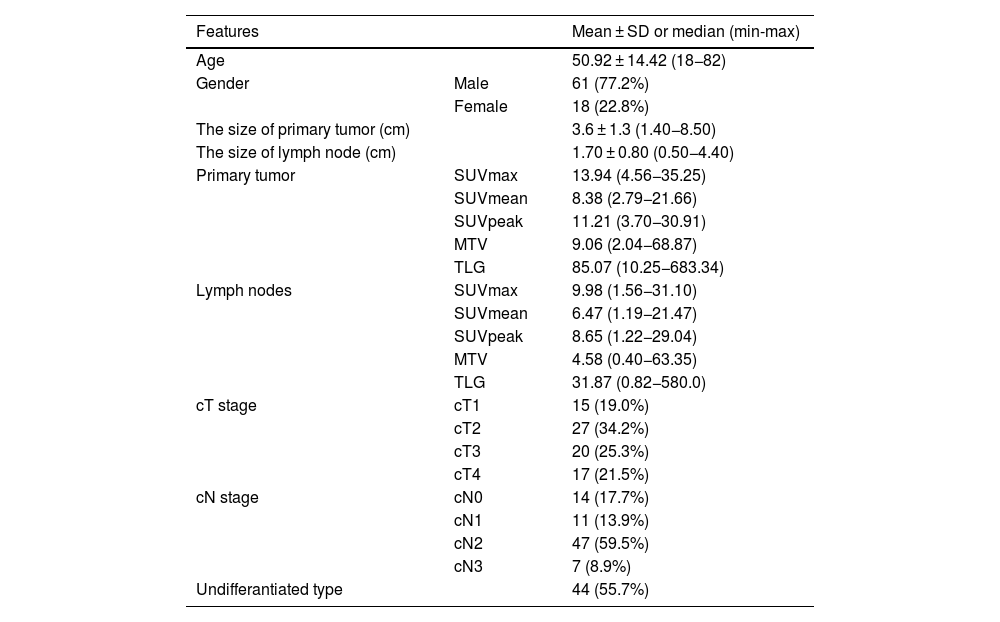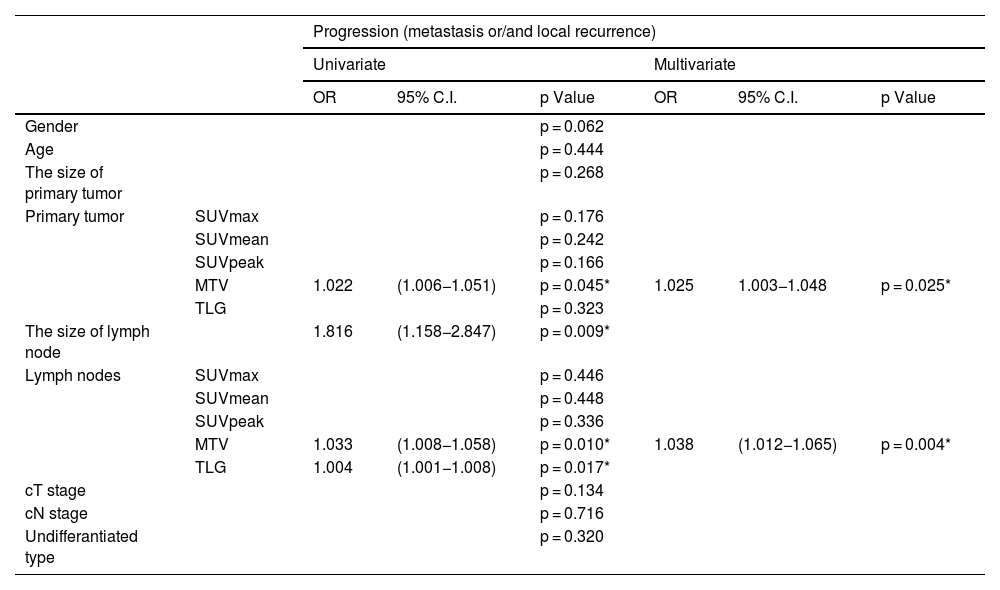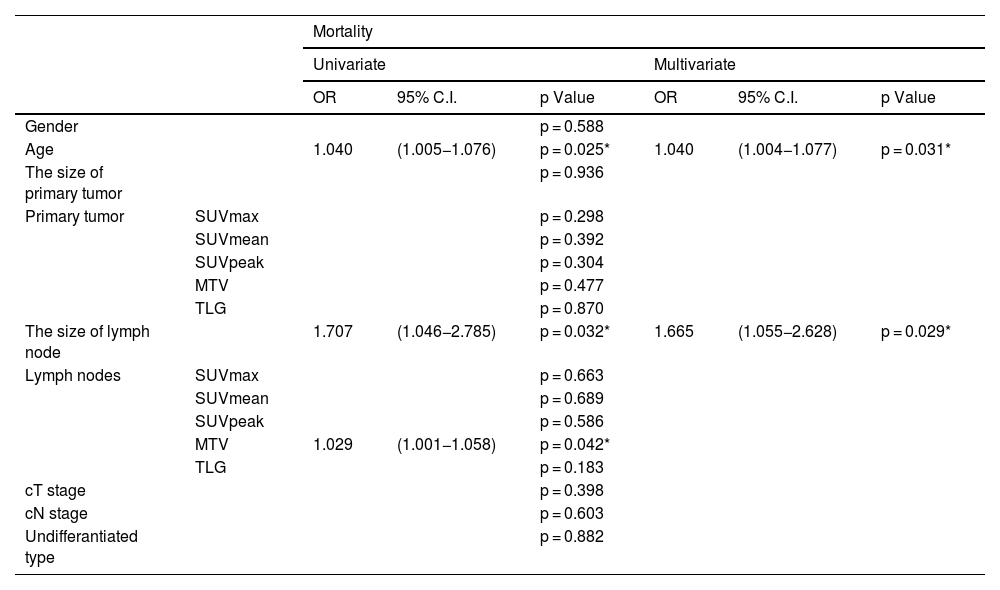The aim of this study was to evaluate the prognostic significance of volumetric metabolic parameters of pre-treatment PET/CT along with clinical characteristics in patients with non-metastatic nasopharyngeal carcinoma.
Material and methodsSeventy-nine patients with nasopharyngeal carcinoma underwent F18- FDG PET/CT for pretreatment evaluation and included in this study. The patient features (patient age, tumor histopathology, T and N stage, size of primary tumor and the largest cervical lymph node) and PET parameters were analyzed: maximum, mean and peak standardized uptake values (SUVmax, SUVmean, SUVpeak), metabolic tumor volume (MTV), and total lesion glycolysis (TLG) for primary tumor and largest cervical lymph node. After treatment, patients were evaluated for disease progression and mortality. Survival analysis for progression-free survival (PFS) and over-all survival (OS) was performed with Kaplan–Meier method using PET findings and clinical characteristics.
ResultsThe median follow-up duration was 29.7 months (range 3–125 months). Among clinical characteristics, no parameters had significance association for PFS. Primary tumor-MTV and cervical lymph node-MTV were independent prognostic factors for PFS (p = 0.025 and p = 0.004, respectively).Patients with primary tumor-MTV >19.4 and patients with lymph node-MTV>3.4 had shorter PFS. For OS, age and the size of the lymph node were independent prognostic factor (p = 0.031 and p = 0.029).Patients with age over 54 years and patients with lymph node size >1 cm were associated with decreased OS.
ConclusionPrimary tumor-MTV and lymph node-MTV on pre-treatment PET/CT are significant prognostic factors for long-term PFS in non-metastatic nasopharyngeal carcinoma.
We consider that measuring MTV as volume-based metabolic parameter on pretreatment PET/CT may contribute decision of treatment intensity and individualized risk stratification and may improve long-term PFS. Additionally, age and the size of lymph node are independent prognostic factors for mortality.
El objetivo de este estudio fue evaluar el significado pronóstico de los parámetros metabólicos volumétricos de la PET/TC pretratamiento junto con las características clínicas en pacientes con carcinoma nasofaríngeo no metastásico.
Material y métodosSetenta y nueve pacientes con carcinoma nasofaríngeo se sometieron a F18-FDG PET/TC para evaluación previa al tratamiento y se incluyeron en este estudio. Se analizaron las características del paciente (edad, histopatología del tumor, estadio T/N, tamaño del tumor primario y ganglio cervical más grande) y parámetros PET: valores de captación estandarizados máximo, medio y pico (SUVmax, SUVmean, SUVpeak), volumen tumoral metabólico( MTV) y glucólisis de lesión total (TLG) para el tumor primario y el ganglio linfático cervical más grande. El análisis de supervivencia para la supervivencia libre de progresión (PFS) y la supervivencia global (OS) se realizó con el método de Kaplan–Meier utilizando los hallazgos de PET y las características clínicas.
ResultadosLa mediana de duración del seguimiento fue de 29,7 meses (rango 3–125 meses). El MTV del tumor primario y el MTV de los ganglios linfáticos cervicales fueron factores pronósticos independientes para la SLP (p = 0,025 y p = 0,004, respectivamente). Los pacientes con MTV del tumor primario > 19,4 y los pacientes con MTV de los ganglios linfáticos > 3,4 tuvieron una SLP más corta. Para OS, la edad y el tamaño del ganglio linfático fueron factor pronóstico independiente (p = 0,031 y p = 0,029). Los pacientes mayores de 54 años y los pacientes con ganglios linfáticos >1 cm se asociaron con una SG disminuida.
ConclusiónEl MTV del tumor primario y el MTV de los ganglios linfáticos en la PET/TC previa al tratamiento son factores pronósticos significativos para la SLP a largo plazo en el carcinoma nasofaríngeo no metastásico.
Consideramos que la medición del MTV como parámetro metabólico basado en el volumen en la PET/TC previa al tratamiento puede contribuir a la decisión de la intensidad del tratamiento y la estratificación del riesgo individualizado y puede mejorar la SLP a largo plazo. Además, la edad y el tamaño de los ganglios linfáticos son factores pronósticos independientes de mortalidad.
Article

Revista Española de Medicina Nuclear e Imagen Molecular (English Edition)











